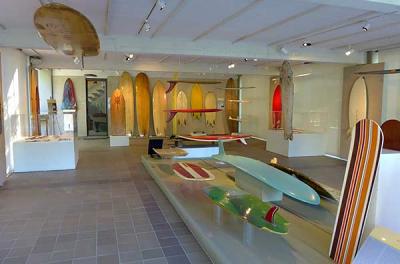In ‘Surf Craft’ at LongHouse, Form and Function Become Art

On Friday afternoon, Chris Harmon of East Hampton, one of the more outstanding surfers to grow out of Long Island waves, crouched, nearly knelt, before a finely shaped length of fiberglass-coated polyurethane foam, virtually flat, the nose of it pointed with a forked tail, two fins, a red deck, and white bottom.
“It’s exactly like my board. The board I’m riding now. It’s the same board,” he repeated. “I’ve got to see the bottom. Can I see the bottom?” The answer was “no,” but he understood.
The 8-foot-8-inch surfboard is an early twin fin shaped by the late Ricky Rasmussen of Westhampton — Mr. Harmon’s predecessor in the outstanding local surfer department — for Tony Caramanico of Montauk in 1981.
The board lay within the no-touch zone among 40 other beautiful statements of form and function — some new, some more than a century old. Together they make up the “Surf Craft: Design and Culture of Board Riding” installation at LongHouse Reserve in East Hampton.
Friday’s opening was attended by at least 100 folks, a mix of knowing and appreciative surfers, as well as unknowing yet obviously wowed non-surfers. The shapes may have been foreign, but they spoke to that part of the brain that senses a purpose behind the design, something studied, the result of trial and error. They are examples of that mystical place where form and function meet and become art.
The show presents three examples of Bob Simmons designs that he brought to life in balsa and fiberglass resin in the 1950s. Mr. Simmons revolutionized surfboard design by abandoning the 100-pound, solid wooden boards that grew out of Polynesian history in favor of boards that were lighter by virtue of materials developed during World War II and the hydrodynamic theories of a naval architect named Lindsey Lord. Mr. Lord was brought into the government fold after Uncle Sam realized it was his flat-bottomed planing hulls that permitted rumrunners to outpace the Coast Guard during Prohibition.
Richard Kenvin, a “surf historian” who curated the collection of boards from the early-20th century, was on hand Friday “talking story,” as surfers say. When asked, he said it was the “Simmons on the left,” a balsa twin fin (Simmons also proved the utility of a skeg or fin for turning and stability) that he would choose if he could have only one board from the collection — a tough choice.
He said the Lis Fish would be his second choice, another revolutionary design shaped by Steve Lis, a surfer, in the early ’70s.
There are the groundbreaking (or is it “water-breaking”) designs of George Greenough, discs that seemed Japanese in their simplicity, that are ridden on one’s knees. There is another kneeboard interpretation by Terry Hendricks called Isurus, Greek for mako shark, a board that at first looks like a piece of bark from a tree but is a crude, yet beautiful, wave rider carved from a log by an anonymous surfer in Sao Tome on the equatorial coast of West Africa.
The boards in the LongHouse show represent only about a third of those featured in a coffee-table book Mr. Kenvin has edited. The California native began surfing in 1970. He does not own all the boards on display. They are from private collections, but Mr. Kenvin admitted he was a surfboard hoarder who has ridden all the boards he hoards, a number he could not quite bring to mind.
He said his fascination with surfboard design began with 12 years of research on Bob Simmons that blossomed into a 2012 exhibition in San Diego called “Pacific Standard Time,” part of an effort by the Getty Museum to collect and interpret the art of Southern California.
Mr. Kenvin said that by then he had visited the Bishop Museum in Honolulu and discovered and studied “The Unknown Craftsman: A Japanese Insight Into Beauty” by Soetsu Yanagi and Bernard Leach, a book about the philosophy of design, “and how it, craft and design, went into the industrial age, how it all fits together, and how it relates to surfing. One thing led to another and I was asked to curate a show. It was called ‘Surf Craft’ at a museum in Balboa Park.”
To Mr. Harmon, the red Rasmussen is a totem, a shape with powers that convey not only its own place in surfing history but one that also expresses a personal relationship with the sea and its waves that he could obviously feel by simply gazing upon it.
Not everyone will have that level of appreciation, and yet visitors to the “Surf Craft” show, set as it is within the extraordinary beauty of LongHouse Reserve, will leave realizing they know art when they see it.
The fascinating story of every board is presented in easily read plaques, and there is a video screen where visitors can watch the shapers do their thing. The show, installed with the help of Michael Rosch and Scott Bluedorn, will run through Oct. 10.
